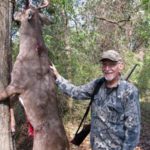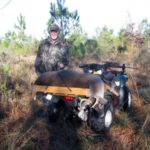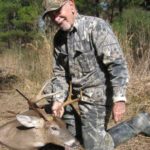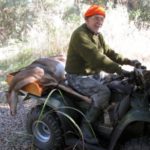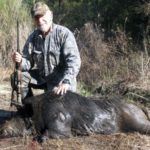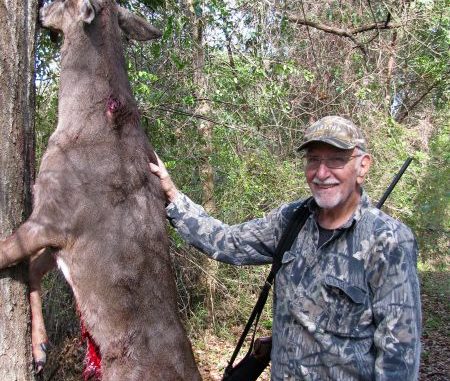
Hunting South Louisiana’s deer is nothing like what is shown on the Outdoor Channel. But tag along with this 89-year-old who still humps it into pine thickets to learn how he continues collecting backstrap for the family gatherings.
“What a joke!” came the yell. “Why do I even bother watching this stuff? Deze guys ain’t hunting — not the way we do it down here in South Louisiana! They’re hunting a different animal on a different planet! Geeesh!”
The yell came from my father, who was watching one of those deer hunting shows on a national network. You know — the ones where the hunter can see for about half a mile in every direction around the stand and huge bucks bumble through what looks like a golf course in broad daylight.
What a joke, indeed!
In December 2001 issue of Louisiana Sportsman I published an article titled “Hunt Hard — Stay Young.” I marveled that a 75-year-old man (my father Humberto N. Fontova) could hunt ducks and deer as fanatically as his kids and grandkids.
And we’re not talking catered hunts here. We’re talking mostly roughing-it hunts on South Louisiana public land and on rough-and tumble Southeast Louisiana piney-woods leases.
Plus, this hunting is from portable ladder stands in thick timber — not heated boxstands over lush and picturesque two- acre foodplots amidst cropland.
The aforementioned yell of outrage came from the subject of that 2001 story. But it came a week after Notre Dame’s field goal beat “our Tigers” at the Music City Bowl.
Les Miles was — more or less — a hero at the time. That game was Dec. 30, 2014.
I know, I know — seems like a lifetime ago that Miles was a hero. But please bear with me.
Point is: The yell came only last year.
Humberto N. Fontova still deer hunts as fanatically — and in the same manner — at age 89 as he did when featured in Louisiana Sportsman’s original “Hunt-Hard — Stay Young.”
Health gurus regale us with drugs, potions and regimens for a long, active and happy life. But I’ve yet to see one prescribe hunting.
Yet I’ve never seen anything remotely as effective. That the hunts are shared with kids and grandkids, and the trophies (antlers or no antlers — and whatever their size) are shared during family feasts, holiday celebrations, tailgate paaawties, etc. — just might contribute to the amazing success of the Fontova family’s prescription for a long and happy life.
Dad’s ladder stand had stood at the same location since the week after Thanksgiving (long by our standards.) By Christmas the trails leading to the corn (very widely dispersed by hand) bait station looked like cattle ruts.
But it was obviously nighttime action.
Three hunts — two morning, on evening — and no sightings.
“Time to move the stand,” says our deer-hunting regimen.
“Wait-a-minute,” some say. “Move a stand with only two weeks left in the season. Good grief!”
In fact, for us, it’s probably the most important move of the season — after the initial placement back in late October.
Here’s why:
A) Usually by this time of year the rut is finally raging in Southeast Louisiana’s piney woods.
B) Many of the food sources available in early November (acorns and browse) have vanished. The prime browse vanished from freezes. The acorns vanished mostly from high creeks and branches flooding oak bottoms and washing away or rotting the water oak acorns that littered the floor in early season.
Consequently, our (widely dispersed) corn becomes all the more attractive both to the does that attract bucks this time of the year — and to ravenous bucks themselves as they expend energy during the rut.
So it was time to bite the bullet and follow those cattle-rut-like trails out from the makeshift bait station and try to get a handle on where these deer are hanging during daylight hours.
Sure, we patterned them back in October, but by now most of the deer had patterned us.
“I have a pretty good guess where these trails lead,” I said as we disassembled the lightweight aluminum ladder stand.
“Of course,” dad answered. “That ghastly thicket near the logged-out bottom. The one that we noticed all the deer trails led into — like spokes on a wheel. ‘All roads lead to Rome,’ we remarked during that pre-season scouting trip. And all deer trails around here lead to this thicket.”
As we lugged the lightweight aluminum ladder stand into the edge of that centralized thicket, we were pleasantly surprised.
A “thicket” in South Louisiana’s piney woods in late October is a seemingly impenetrable tangle of thorns, stickers, vines and branches.
Only armadillos dare to venture within.
Armadillos and deer that is.
Get down on your knees on the edge and look inside: That’s about what a deer faces. As well known by Louisiana hunters, our hard-hunted and super-wily deer manage to weave their way into these tangles alongside the armadillos — to spend most of their daylight hours in cozy safety, laughing at the two-legged fools perched along food plots and power lines.
As we trudged into the thicket almost at a crouch, pushing spiny vines from our arms, our curses slowly mellowed into exclamations of a much more amiable sort.
Alas! In mid January the same thicket looks much different. You see, it’s all about the type of vegetation that comprises the thicket.
In our case, the thicket — courtesy of a 12-year-old clear cut — was mostly comprised of water oak, swamp maple, tallow, willow and black-gum saplings. It was a branch bottom that had been mostly logged out along with the surrounding pines over a decade earlier.
The saplings in this thicket were weaved tightly together with blackberry, trumpet creeper and smilax vines, and interspersed with tall, wall-like groves of swamp titi (aka cyrilla).
But here’s the thing that switched us from cursing to high-fiving: The oaks, gums, tallow, willow and maple saplings lose most of their leaves by January. Even the swamp titi, blackberry and privet shed many leaves.
Most of us confine our scouting to pre-season and the early part of the season. So when we encounter such thickets, we roll our eyes and elect to set up along the edges in the hopes of catching the exasperatingly wily South Louisiana deer either sneaking in or out at the very last minutes of the morning or evening.
Given the classically wet January conditions, the deer trails crisscrossing the thicket were a cinch to find once we got inside.
It probably took us an hour and a half of scrutiny to finally pick the stand site — an intersection of three deeply rutted trails, one of them marked every 30 yards or so by rubs, both old and fresh.
Yep. We had our spot, especially since visibility — owing to the factor mentioned earlier of shed leaves and shriveled vines — was about 40 to 50 yards, mostly out in front of the water oak where we placed the stand.
A hundred pounds of corn spread very widely in the “open” area of the thicket and along the three trails leading to it sweetened the setup.
I set up my climber in a small pine on the edge of the thicket about 400 yards away from dad.
The hunt was still a week away. A cold front would sure help, preferably a day or two before the hunt. We always do best in that situation — but usually during late morning (9:30 to 11:30 a.m.), after the frost has melted off from the sun.
And, sure enough, a cold front barreled through with perfect timing. So our hopes were high as we crunched through the thin ice on the way to our stands.
But by 10:25 a.m., with the sun high, I was shrugging off the hunt and giving deep thanks for the simple blessing of a gorgeous winter morning in the woods with my 89-year-old dad …
Wait: I spotted movement through the pines on my left!
A bird? Another crow? They’d been flying and cawing around me all morning.
No — a DEER! And another behind it!
My heart started hammering. The does were maybe 70 yards out crossing through a sage clearing.
My legs felt rubbery. My knees started knocking.
“Surely there’s a buck chasing them!” I told myself as my entire body convulsed in tremors. “How on earth will I keep these crosshairs steady?”
I peered through the fogged-up scope.
“Pe-TOW!”
The shot almost knocked me from the stand. Thankfully, I was harnessed up good and tight.
But the shot wasn’t mine.
“Musta been dad! No one else’s hunting out here this morning,” I thought to myself.
The does picked up speed and entered the thicket.
“Better keep my rifle up,” I thought. “A buck SHOULD be following!”
For 10 minutes, I kept the gun up and aiming. Finally my convulsions subsided — just as the iPhone buzzed.
“Big buck DOWN!” Dad gasped. “I can SEE him!”
“Be RIGHT THERE!” I said.
I almost killed myself unharnessing and humping it down the tree with trembling hands and knocking knees.
I hit the ground stumbling, and continued stumbling the 400 yards through the thicket.
I saw it from 50 yards off. What luck! A shaft of sunlight penetrated through the gums and water oaks and hit the antlers perfectly, illuminating them — in all their glory!
The whoops and hugs probably lasted 10 minutes.
The high-fives continued for another hour — another year, actually!
